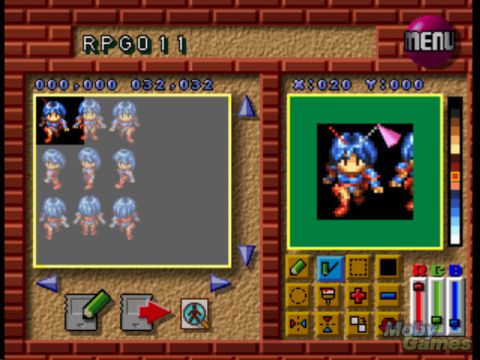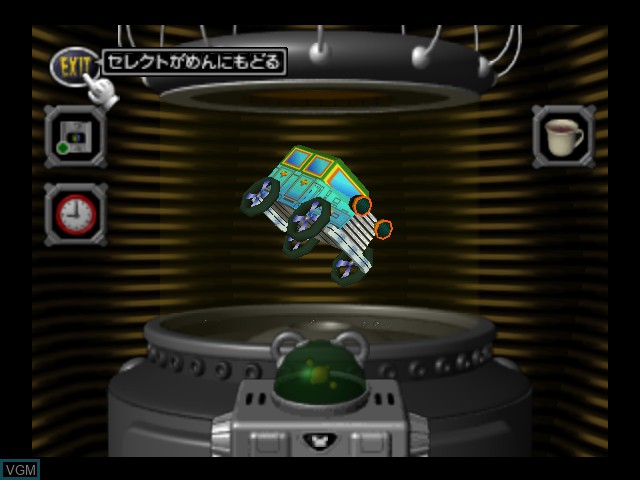
Nintendo has just released Game Builder Garage for Switch, which allows players to create all kinds of nifty games like shooters, platformers, fighters, and more. This made me think about all the games in the past that have allowed players to create their own games. Believe it or not, Nintendo has done more in this area than anyone else, but there are also some notable companies who have contributed. If you're a creative person (like me), then you love games that let you create your own characters, make cool levels, or just mess around. So let's look back at games that have allowed us to dig into our inner Da Vinci. (Please note that these are games focused completely on game creation, not just games that have some kind of game customization in them, otherwise we'd be here all day)
RPG Maker (PS1, 1997/2000)

Truly ambitious for its time, AgeTec's RPG Maker on Playstation allowed players complete control over every aspect of an RPG, from characters to dialog to story events and even music. The problem is, making a full RPG would take very long. Menus here are complicated (not user-friendly at all), so learning the ins and outs will take time. Characters and monsters can be made either using presets or making them by scratch. The game allows you to use the PSX mouse, which is good because it will take you an eternity to make dialog via a controller. The game also has Anime Maker, which gives you a lot of customization in making characters, title screens, and backgrounds. Once your RPG is finished, you can save it to your memory card and give it to another player to try out.
Since its debut, RPG Maker has become a huge series on PC. Making something on your computer is far more intuitive than doing it on a game console. Today there are different versions of RPG Maker, such as RPG Maker MZ, RPG Maker MV, and RPG Maker VX Ace. These have all been simplified so that anyone can make an RPG without any programming or coding skills. Pretty amazing!
Mario Artist series (N64DD, 1999)

If you recall, the 64DD was an add-on to the N64 that was only released in Japan. The Mario Artist series consisted of four games: Paint Studio, Talent Studio, Communication Kit, and Polygon Studio. These were quite ambitious, allowing players to create things and even share them online. Polygon Studio allowed you to create your own custom polygon model and then use it in an open 3D environment. You could even make a 3D avatar and put your face on it (which would become the precursor to the Mii). Sadly, the 64DD (which was released only in Japan) was a huge flop, and subsequent Mario Artist games were canceled. One of them was titled "Game Maker," and we can only speculate exactly what it had to offer, but possibly it would have allowed players to create their own 3D game (which would have been very impressive for the time).
WarioWare D. I. Y. (DS, 2010)

This seventh title in the WarioWare series allows players to create their own microgames (which includes both graphics and music). The game has five sections: D.I.Y. Studio (the player designs microgames), WarioWare Inc. (the tutorial), D.I.Y. Shop (the player makes microgame cartridges), Options Garage (the player edits preferences and names), and Distribution Center (the player sends games to the Wii or vice versa). When making music, the player can simply hum into the microphone and the game will convert it into notes, which can then be played via different instruments. Players could also play their games on the Wii by using the WiiWare game WarioWare D.I.Y. Showcase, which let players play with a Wii remote instead of touch controls. And of course, a big part of the game was sharing your creations with other players and playing theirs as well, but this ended in 2014 with the shutdown of Nintendo Wi-Fi Connection. If Nintendo ever brings back WarioWare, they should bring back this game and update it for the Switch. Making your own microgames can be a lot of fun.
Super Mario Maker series (Wii U/3DS/Switch, 2015-)

The Mario Maker games are by far the most intuitive game-making games ever released. Who wouldn't want to make their own Mario levels? It was a genius idea, and Nintendo knew it. The Wii U was the perfect system for it too, since you could use the gamepad to simply drag and drop things into your level. The amount of customization here is staggering, especially for the second game on Switch, which added quite a bit of new content. Perhaps the most impressive thing is the ability to mix and match enemies and objects, which had never been seen before in Mario games (atleast not to this extent). Making your own levels is a blast, but it's also fun to play levels that other creators have made. Because of how simple these games are and because they feature gaming's most iconic character, the series is the most popular game-making series to date. It's not perfect, but hopefully Nintendo will keep the series going and try to continue to refine the experience.
Nintendo Labo--Toy-Con Garage (Switch, 2019)

I'm sure you're familiar with Nintendo Labo, makeshift cardboard creations that allowed players to interact with games in the real world. Very cool idea, but Nintendo took it to the next level with Toy-Con Garage, which allowed players to mix and match their cardboard creations and program simple functions into them. Players are hindered only by the limits of their imaginations, and some players have made some incredible things! Nintendo has showcased some of these, such as one player making an analog clock with an alarm, and another a solar-powered cardboard accordion. No doubt Toy-Con Garage was the precursor to Nintendo's Game Builder Garage, their first ever full-on game maker (this time, no cardboard required).
NESmaker (PC, 2019)

OK, so this one's technically not a game, but I had to include it because it's so amazing! The story goes that a couple guys were making their very own NES game when it dawned on them that they could make their simple-to-use software available to other creators to make their own NES games too. Thus, NESmaker was born. For just $36, you can get a commercial license and full access to all the premade assets to make your own game. In addition, you can also download (for free) modules for specific genres that will help you out, or you can do all your own spritework. When you're done making your game, you can transfer all the data to an actual NES cartridge and play it on the NES! This is truly impressive, and the guys at NESmaker have had some competitions the last couple years for creators. You can check out the NESmaker website here.
Dreams (PS4/PS5, 2020)

Created by Media Molecule, Dreams would be the game that most resembles Nintenod's Game Builder Garage. There's a lot you can do here. An imp becomes your playable avatar, allowing you to access other dreams (games) and make your own. You can design your own scenes, models, effects, and elements. You can also use premade assets, of course. The game offers plenty of tutorials to help you along. You use "gadgets" to link things together, such as animation, lighting, and sound. Players can publish their creations online to the "Dreamiverse" so others can play them, and they can even make it re-mixable, allowing other creators to use it, build on it, or tweak it. There are also in-game achievements called imp quests. As you can see, Dreams offers a lot, and it's a great toolset for those that are creative and curious about making games.
The fact is, if you want to make a game these days, there are TONS of game creation software options available that don't require any programming or coding skills (what a time we live in). Drag and drop is always nice, right? Thanks for reading, and be sure to let me know if I missed any games that focus on making games down in the comments.











Comments